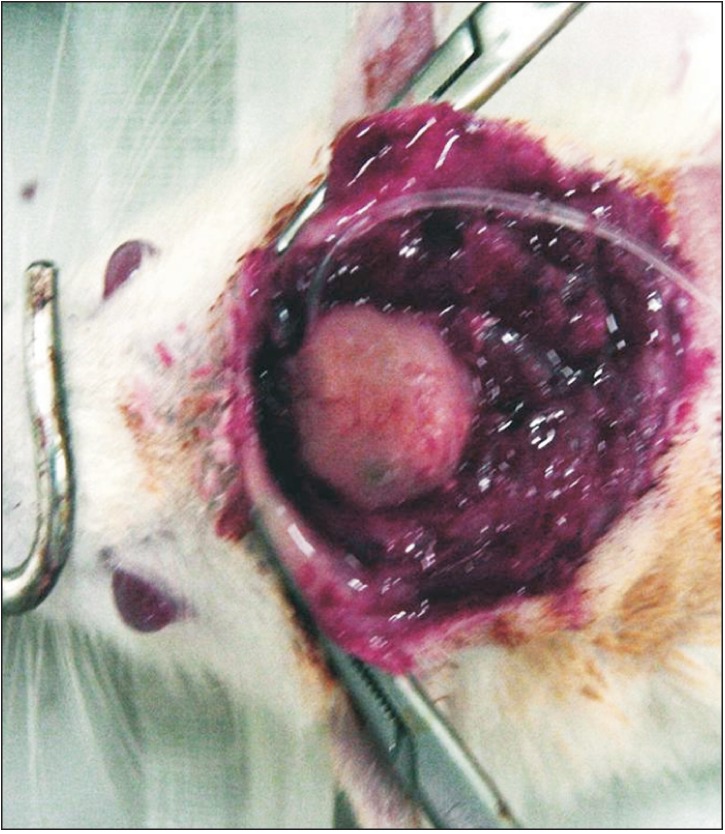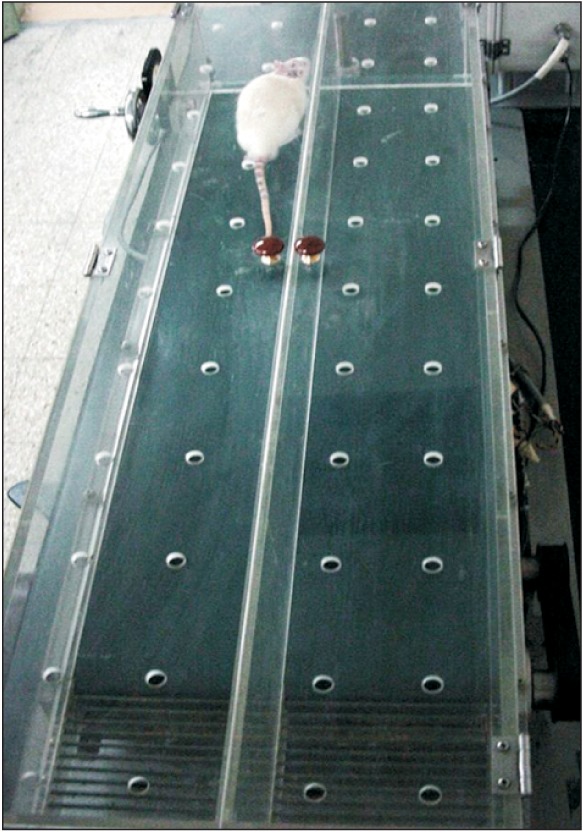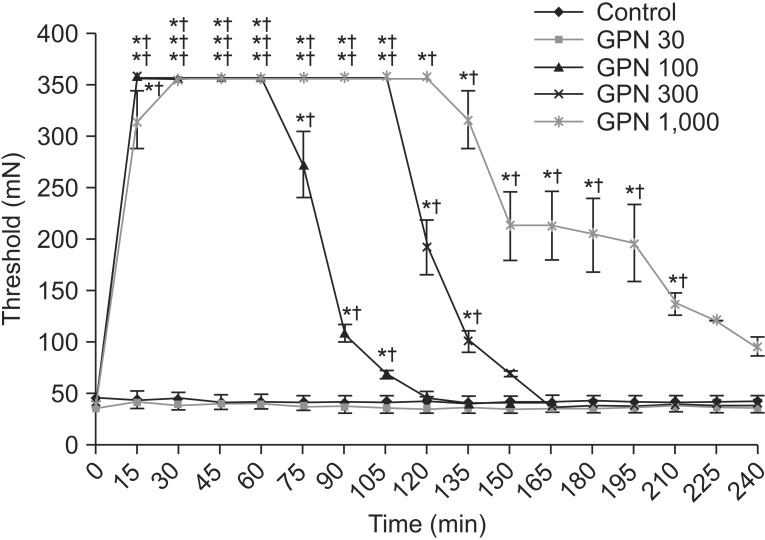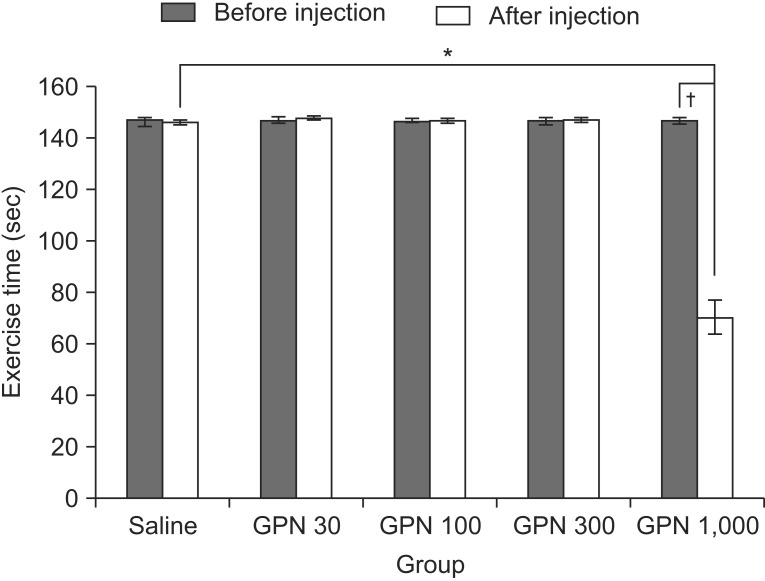Ann Rehabil Med.
2014 Oct;38(5):682-688. 10.5535/arm.2014.38.5.682.
Analgesic Effect of Intrathecal Gabapentin in a Rat Model of Persistent Muscle Pain
- Affiliations
-
- 1Department of Physical Medicine and Rehabilitation, Sun General Hospital, Daejeon, Korea. rmactksk@daum.net
- 2Department of Physical Medicine and Rehabilitation, Chungnam National University Hospital, Daejeon, Korea.
- KMID: 2266503
- DOI: http://doi.org/10.5535/arm.2014.38.5.682
Abstract
OBJECTIVE
To evaluate the analgesic effect of intrathecal gabapentin therapy on secondary hyperalgesia in a rat model of persistent muscle pain.
METHODS
Intrathecal catheters were implanted into rats. Mechanical secondary hyperalgesia was induced by repeated intramuscular injections of acidic solution into the gastrocnemius muscle. Gabapentin was administrated intrathecally. Rats were allocated to control and experimental (gabapentin 30, 100, 300, and 1,000 microg) group. After gabapentin administration, mechanical withdrawal threshold was measured every 15 minutes and the motor function was measured 30 minutes later.
RESULTS
Mechanical hyperalgesia was evoked after the second acidic buffer injection. There was a significant improvement on the mechanical threshold after administration of 100, 300, and 1,000 microg gabapentin compared to pre-injection and the control group. The analgesic effect continued for 105, 135, and 210 minutes, respectively. To discern side effects, motor function was measured. Motor function was preserved in both groups after gabapentin administration, except for rats who received 1,000 microg gabapentin.
CONCLUSION
Intrathecal gabapentin administration produces dose-dependent improvements in mechanical hyperalgesia in a persistent muscle pain rat model. This implicates the central nervous system as having a strong influence on the development of persistent mechanical hyperalgesia. These results are helpful in understanding the pathophysiology of secondary hyperalgesia and in the treatment of patients with chronic muscle pain.
MeSH Terms
Figure
Reference
-
1. Kim C. Chronic pain syndrome. J Korean Assoc Pain Med. 2003; 2:17–24.2. Sohn MK, Lee KY, Yang SS, Lee SH, Kim SS. Development and assessment of animal model of persistent muscle pain. J Korean Acad Rehabil Med. 2003; 27:757–763.3. Sluka KA, Kalra A, Moore SA. Unilateral intramuscular injections of acidic saline produce a bilateral, long-lasting hyperalgesia. Muscle Nerve. 2001; 24:37–46. PMID: 11150964.
Article4. Sohn MK, Kang SK, Lee SH, Han SM. The mechanism of contralateral hyperalgesia in the persistent muscle pain rat model. J Korean Acad Rehabil Med. 2004; 28:477–482.5. Sohn MK, Yoon YS, Lee SH, Kang SK, Kim BO, Sohn JH. The effect of low-level laser irradiation on activities of dorsal horn neurons in rats with experimental muscle pain. J Korean Acad Rehabil Med. 2005; 29:513–520.6. Suh DW, Kim SJ. Effects of drugs for pain relief on neuropathic animal model. J Korean Acad Rehabil Med. 1996; 20:17–27.7. Fink K, Meder W, Dooley DJ, Gothert M. Inhibition of neuronal Ca(2+) influx by gabapentin and subsequent reduction of neurotransmitter release from rat neocortical slices. Br J Pharmacol. 2000; 130:900–906. PMID: 10864898.8. Kukkar A, Bali A, Singh N, Jaggi AS. Implications and mechanism of action of gabapentin in neuropathic pain. Arch Pharm Res. 2013; 36:237–251. PMID: 23435945.
Article9. Segal AZ, Rordorf G. Gabapentin as a novel treatment for postherpetic neuralgia. Neurology. 1996; 46:1175–1176. PMID: 8780121.
Article10. Levendoglu F, Ogun CO, Ozerbil O, Ogun TC, Ugurlu H. Gabapentin is a first line drug for the treatment of neuropathic pain in spinal cord injury. Spine (Phila Pa 1976). 2004; 29:743–751. PMID: 15087796.11. Bone M, Critchley P, Buggy DJ. Gabapentin in postamputation phantom limb pain: a randomized, double-blind, placebo-controlled, cross-over study. Reg Anesth Pain Med. 2002; 27:481–486. PMID: 12373695.
Article12. Backonja M, Beydoun A, Edwards KR, Schwartz SL, Fonseca V, Hes M, et al. Gabapentin for the symptomatic treatment of painful neuropathy in patients with diabetes mellitus: a randomized controlled trial. JAMA. 1998; 280:1831–1836. PMID: 9846777.
Article13. Yaksh TL, Rudy TA. Chronic catheterization of the spinal subarachnoid space. Physiol Behav. 1976; 17:1031–1036. PMID: 14677603.
Article14. Chaplan SR, Bach FW, Pogrel JW, Chung JM, Yaksh TL. Quantitative assessment of tactile allodynia in the rat paw. J Neurosci Methods. 1994; 53:55–63. PMID: 7990513.
Article15. Graven-Nielsen T, Arendt-Nielsen L, Svensson P, Jensen TS. Quantification of local and referred muscle pain in humans after sequential i.m. injections of hypertonic saline. Pain. 1997; 69:111–117. PMID: 9060020.
Article16. Hamamoto DT, Ortiz-Gonzalez XR, Honda JM, Kajander KC. Intraplantar injection of hyaluronic acid at low pH into the rat hindpaw produces tissue acidosis and enhances withdrawal responses to mechanical stimuli. Pain. 1998; 74:225–234. PMID: 9520237.
Article17. Kim YS, Chang HK, Lee JW, Sung YH, Kim SE, Shin MS, et al. Protective effect of gabapentin on N-methyl-D-aspartate-induced excitotoxicity in rat hippocampal CA1 neurons. J Pharmacol Sci. 2009; 109:144–147. PMID: 19151547.
Article18. Park S, Ahn ES, Han DW, Lee JH, Min KT, Kim H, et al. Pregabalin and gabapentin inhibit substance Pinduced NF-kappaB activation in neuroblastoma and glioma cells. J Cell Biochem. 2008; 105:414–423. PMID: 18615578.19. Bockbrader HN, Wesche D, Miller R, Chapel S, Janiczek N, Burger P. A comparison of the pharmacokinetics and pharmacodynamics of pregabalin and gabapentin. Clin Pharmacokinet. 2010; 49:661–669. PMID: 20818832.
Article20. Takasu K, Ono H, Tanabe M. Gabapentin produces PKA-dependent pre-synaptic inhibition of GABAergic synaptic transmission in LC neurons following partial nerve injury in mice. J Neurochem. 2008; 105:933–942. PMID: 18182059.
Article21. Latremoliere A, Woolf CJ. Central sensitization: a generator of pain hypersensitivity by central neural plasticity. J Pain. 2009; 10:895–926. PMID: 19712899.
Article22. Wen YR, Tan PH, Cheng JK, Liu YC, Ji RR. Microglia: a promising target for treating neuropathic and postoperative pain, and morphine tolerance. J Formos Med Assoc. 2011; 110:487–494. PMID: 21783017.
Article23. Wodarski R, Clark AK, Grist J, Marchand F, Malcangio M. Gabapentin reverses microglial activation in the spinal cord of streptozotocin-induced diabetic rats. Eur J Pain. 2009; 13:807–811. PMID: 18977160.
Article24. Yang JL, Xu B, Li SS, Zhang WS, Xu H, Deng XM, et al. Gabapentin reduces CX3CL1 signaling and blocks spinal microglial activation in monoarthritic rats. Mol Brain. 2012; 5:18. PMID: 22647647.
Article25. Jun JH, Yaksh TL. The effect of intrathecal gabapentin and 3-isobutyl gamma-aminobutyric acid on the hyperalgesia observed after thermal injury in the rat. Anesth Analg. 1998; 86:348–354. PMID: 9459247.
Article26. Cho HS, Kim MH, Choi DH, Lee JI, Gwak MS, Hahm TS. The effect of intrathecal gabapentin on mechanical and thermal hyperalgesia in neuropathic rats induced by spinal nerve ligation. J Korean Med Sci. 2002; 17:225–229. PMID: 11961308.
Article27. Chu LC, Tsaur ML, Lin CS, Hung YC, Wang TY, Chen CC, et al. Chronic intrathecal infusion of gabapentin prevents nerve ligation-induced pain in rats. Br J Anaesth. 2011; 106:699–705. PMID: 21441243.
Article28. Pan HL, Eisenach JC, Chen SR. Gabapentin suppresses ectopic nerve discharges and reverses allodynia in neuropathic rats. J Pharmacol Exp Ther. 1999; 288:1026–1030. PMID: 10027839.29. Kayser V, Christensen D. Antinociceptive effect of systemic gabapentin in mononeuropathic rats, depends on stimulus characteristics and level of test integration. Pain. 2000; 88:53–60. PMID: 11098099.
Article30. Pandey CK, Navkar DV, Giri PJ, Raza M, Behari S, Singh RB, et al. Evaluation of the optimal preemptive dose of gabapentin for postoperative pain relief after lumbar diskectomy: a randomized, double-blind, placebo-controlled study. J Neurosurg Anesthesiol. 2005; 17:65–68. PMID: 15840990.
- Full Text Links
- Actions
-
Cited
- CITED
-
- Close
- Share
- Similar articles
-
- The Combined Antiallodynic Effect of Gabapentin and Milnacipran in a Rat Neuropathic Pain Model
- Antihyperalgesic Effects of Intrathecal Gabapentin and CNQX, Non-NMDA Receptor Antagonist, in a Rat Model for Postoperative Pain
- The Analgesic Effect of Intrathecal Gabapentin in a Rat Model of Incisional Pain
- Effect of Serotonergic Receptors on the Antinociception of Intrathecal Gabapentin in the Formalin Test of Rats
- The Effects of Gabapentin on Facial Formalin Test





